

Passive transport is the process of transporting molecules from one side of the membrane to the other without any energy requirements.
The transport of materials across the cell membrane is necessary to uphold cellular homeostasis.[1] It’s required to maintain the pH, volume, and accumulation of nutrients for protein synthesis and cell metabolism for organisms to thrive.[1]
The cell membrane is composed of lipids, proteins, carbohydrates, and sterols that interact with each other to facilitate transmembrane transport.[1] The phospholipid bilayer of the membrane has hydrophilic lipid heads facing outside and the hydrophobic tails facing towards each other on the inner leaflet of the membrane. This orientation supports the amphipathic nature of the biological membrane.[1]
The hydrophobicity of the membrane makes it challenging to transport ions, solutes, and other hydrophilic molecules across the membrane, making it selectively permeable.[1] Membrane permeability which is affected by several factors is the physiological property that allows the selective passage of hydrophilic solutes across the hydrophobic barrier. Transport proteins like carriers and channel proteins facilitate the transport of such hydrophilic molecules.[1]
This article provides an in-depth discussion about passive transport, its types, and the molecules or ions it supports to cross the membrane.
Humans, animals, plants, and other organisms utilize different means of transporting materials from one place to another. This unique transportation network circulates food, minerals, hormones, oxygen, carbon dioxide, waste products, etc.[1]
The movement of molecules across the membrane is categorized into two classes, depending on the energy required to execute the process. It includes active transport and passive transport.
It’s the transport of molecules across the membrane against the concentration gradient from low concentration to high concentration. It involves an expenditure of energy in the form of ATP.
The two types of active transport include:
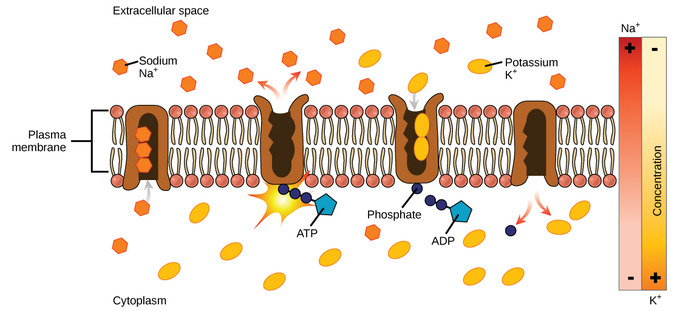
Image: An illustration of sodium-potassium transport against the electrochemical gradient using ATP as energy.[2]
Source: Courses Lumen Learning
Secondary (indirect) active transport: It involves coupling the transport of one molecule with another. The energy-dependent transfer of an ion (Na+, K+, or H+) generates an electrochemical gradient of the ion across the membrane.[3] This ion gradient is coupled to the movement of solutes on the same side (symport) or opposite side (antiport) of the membrane.[3]
It’s the movement of substances across the membrane along the concentration gradient from higher concentration to lower concentration. Thus, it doesn’t require energy.
Passive transport is involved in transferring small molecules of low molecular weight and gases across the membrane. But, instead of utilizing cellular energy, the process relies on the second law of thermodynamics to drive the movement of substance.
Fick’s law of diffusion predicts the rate of diffusion through passive transport. It states that the molar flux due to diffusion is proportional to the concentration gradient.
The two types of passive transport include diffusion and facilitated diffusion.
It’s the movement of materials from an area of high concentration to that of low concentration until the concentration is equal on both sides (gradient neutralization). Diffusion requires no energy expenses; instead, the concentration gradient (in the form of potential energy) is created and utilized during the transport of molecules.[4]
In simple diffusion, molecules or solute particles move in random Brownian motion. And, their flux across the membrane can be calculated using an equation proposed by Torrell in 1953.[4]
Flux = Mobility x Concentration x Driving Force
Here, flux is the number of moles of solute crossing one square centimeter of membrane per second. The concentration measures the amount of material available to participate in the diffusion process, while solute mobility is the ease of transport of molecules.[4]
The difference in the concentration gradient on both sides of the membrane acts as a driving force for molecular transport. When the solute equilibrium is achieved on both sides of the membrane, the flux across the membrane becomes zero.[5]
Simple diffusion occurs only in liquid and gases because of random movements of their particles from one place to another. Examples of molecules transported by simple diffusion include oxygen, carbon dioxide, and ethanol.[5]
Another example of simple diffusion is the transport of water, nutrients, and other gases in prokaryotes like bacteria. In addition, the excretion of waste material is also through simple diffusion in these organisms.[5]
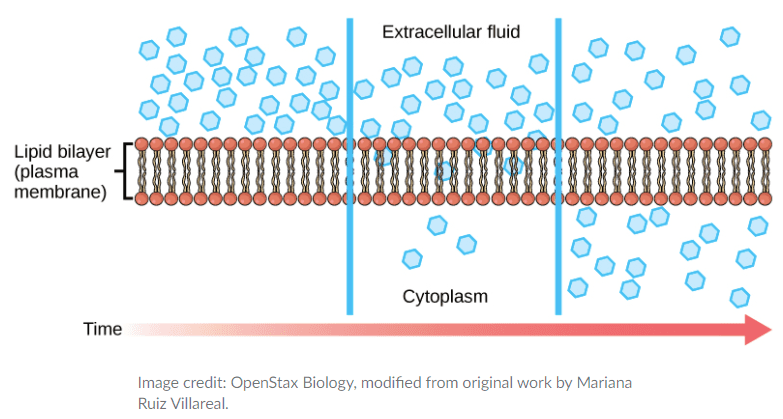
Image: An illustration of simple diffusion through lipid bilayer membrane.[2]
Source: Courses Lumen Learning
Channel-mediated transport is the spontaneous passage of molecules or ions across the biological membrane passing through specific transmembrane integral proteins.[4] These integral proteins are collectively known as transport proteins.
Channel proteins are specific for the materials they transport across the membrane. Structurally, they have hydrophilic domains exposed to the intracellular and extracellular fluids and a hydrophobic channel through their core that provides a hydrated opening through the membrane layers.[4]
The passage created by both domains prevents the polar molecules from coming in contact with the non-polar central layer of the membrane.[4] An example of channel-mediated transport is the passage of water through aquaporins.
Channel proteins are also of two types:
In the kidney, both gated and non-gated channels are found in different parts of the renal tubules. In contrast, nerve cells and muscle cells involved in the transmission of electric impulses have gated channels for sodium, potassium, and calcium in their membranes.
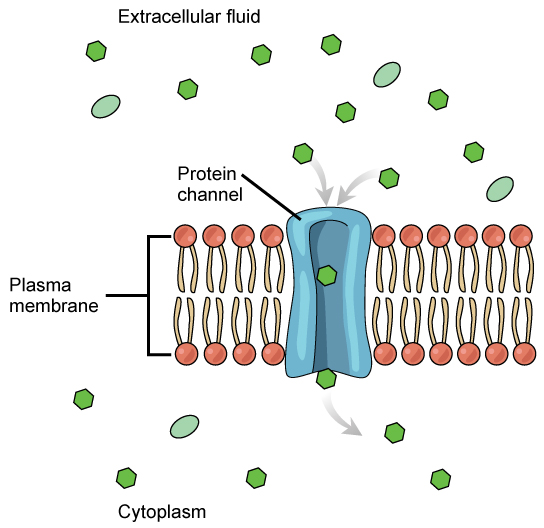
Image: An illustration of channel-mediated transport.[2]
Source: Courses Lumen Learning
The carrier protein bind to the molecules to be transferred that eventually triggers a change in its shape. Then, based on the concentration gradient, the molecule moves across the membrane.
An example of carrier-mediated transport is a group of carrier proteins called glucose transport proteins, or GLUTs, which transport glucose and other hexose sugars through plasma membranes within the body.[4]
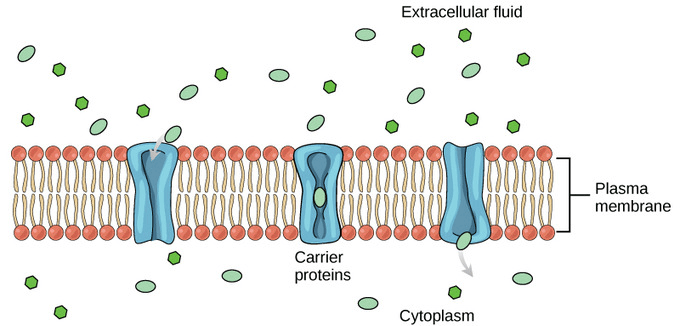
Image: An illustration of carrier-mediated transport.[2]
Source: Courses Lumen Learning
The process of facilitated diffusion depends on several factors like:[7]
The simple diffusion and facilitated diffusion process might seem similar, but there are four significant differences among both techniques. They are:[6]
Other than simple and facilitated diffusion, osmosis and filtration are two other techniques that work on the principle of passive transport. They are also involved in the transfer of certain molecules across biological membranes based on concentration gradient and without any energy expenditure.
It’s a process of transporting solvent molecules from an area of high water potential (lower solute concentration) to lower water potential (higher solute concentration) through a selectively permeable membrane. Any type of gases and supercritical liquids like CO2 can cross the membrane or any other system through the process of osmosis.
The osmotic solutions are of three types:[8]
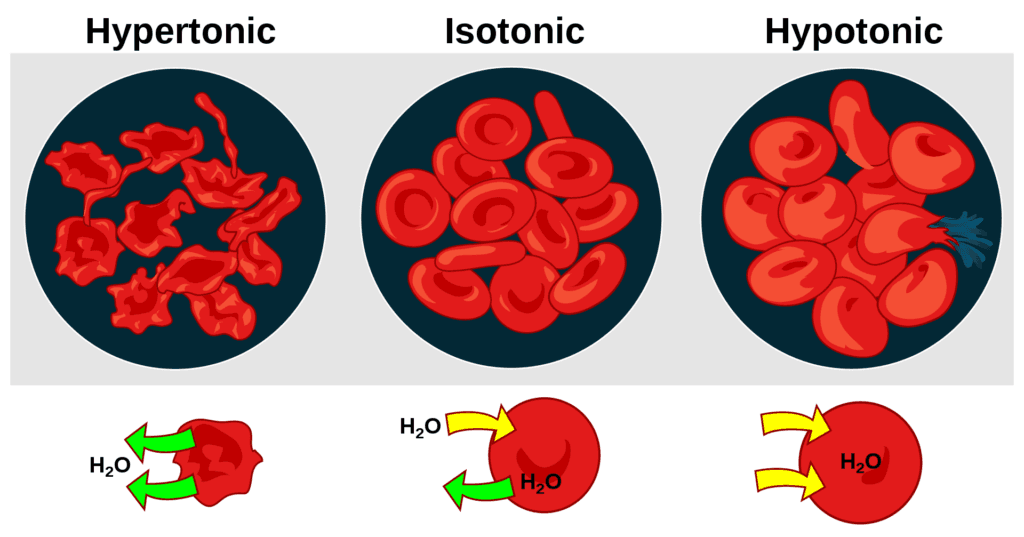
Image: An illustration of the effect of blood cells when placed in solutions of different tonicity.
Source: Wikipedia[9]
Depending on the physiological mechanism occurring in a cell when placed in an osmotic solution, the process of osmosis is of two types:[9]
Stomatal opening in plant cells is an example of osmosis. Here, water enters the cell through osmosis, the guard cells swell up, and the stomata open for the gaseous exchange. Another example is the absorption of water from the soil.[9]
Filtration is the process of separating solids from liquids and gases. It doesn’t require energy expenditure and takes place along the concentration gradient.[10] An example includes the selective absorption of nutrients in the human body. The glomerulus filters the blood in the kidney, and the body reabsorbs the necessary molecules.[10]
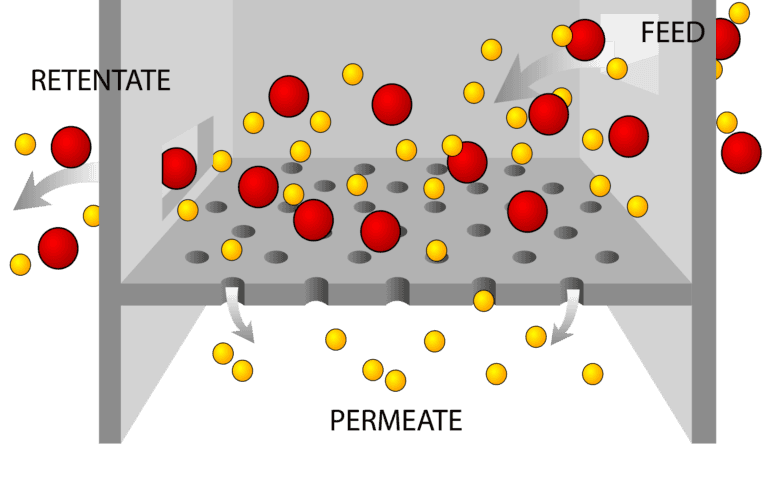
Image: An illustration of the process of filtration.[9]
Source: Wikipedia
Passive transport is a physiological mechanism of transporting molecules across the membrane that favors the concentration gradient. Without any expenditure of energy, the process transfers essential molecules, nutrients, and gases to the organism’s body required for their living. However, channel and carrier proteins present in the membrane also facilitate this transport.
The transport rate depends on the permeability of the cell membrane, which, in turn, depends on the organization and characteristics of membrane lipids and proteins.
Researchers are currently digging up more hidden properties of the membrane and studying their utilization for drug transport during disease treatment. So, despite being an old matter, the area has the novel potential for breakthroughs in health and medicine.
